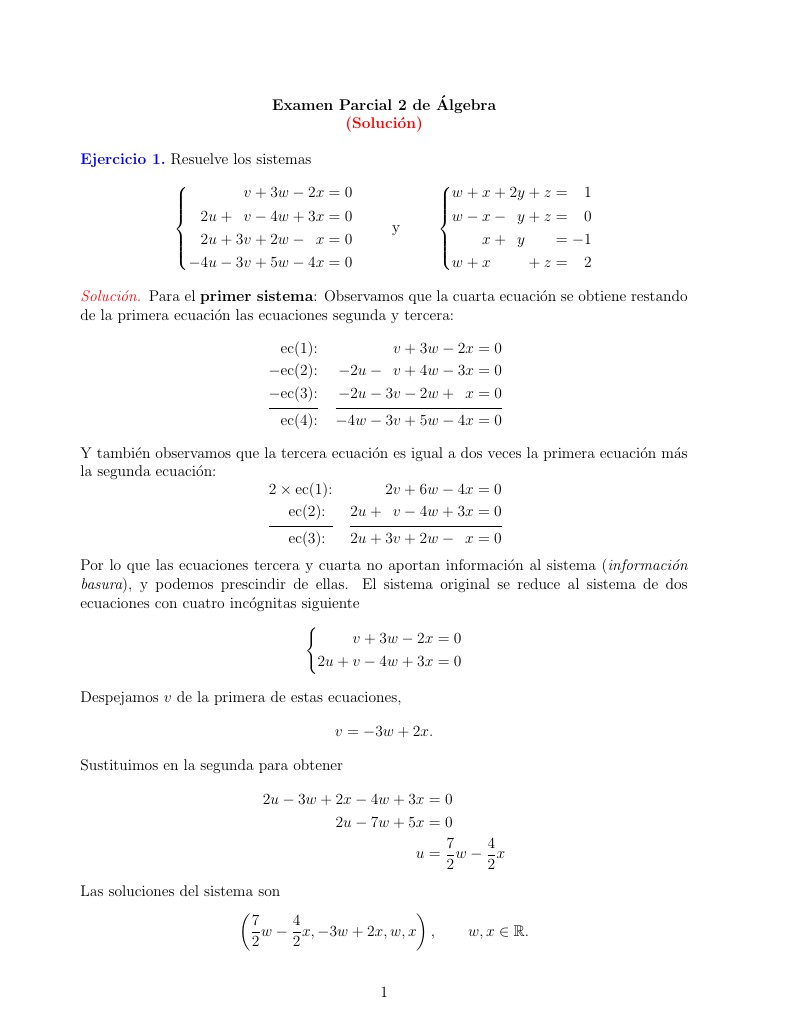
Solución al segundo examen parcial de álgebra

\documentclass[12pt,oneside,geqno]{article}
\addtolength{\textheight}{120pt}
\oddsidemargin=-10pt
\topmargin=-.5in
\textwidth=6.5in
%\pagestyle{empty}
\usepackage{amssymb,latexsym,amsmath,amsthm}
\usepackage{amsfonts,rawfonts}
\usepackage{thmtools}
\usepackage{systeme}
\usepackage{mathtools}
\usepackage[usenames,dvipsnames]{color}
\usepackage{xcolor}
\declaretheoremstyle[
headfont=\color{blue}\normalfont\bfseries,
notefont=\bfseries,
notebraces={}{},
%bodyfont=\color{red}\normalfont\itshape,
bodyfont=\normalfont,%\itshape,
%headformat=\NUMBER.~\NAME\NOTE
headformat=\NAME\NOTE
]{colorejercicio}
\declaretheorem[
%numbered=no,
style=colorejercicio,
name=Ejercicio
]{ejercicio}
\begin{document}
\begin{center}
{\bf Examen Parcial 2 de \'Algebra}
{\bf \color{red}{(Soluci\'on)}}
\end{center}
\begin{ejercicio}[1]
Resuelve los sistemas
\[
\systeme{v+3w-2x=0,
2u+v-4w+3x=0,
2u+3v+2w-x=0,
-4u-3v+5w-4x=0}
\qquad\text{ y }\qquad
\systeme{w+x+2y+z=\phantom{-}1,
w-x-y+z=\phantom{-}0,
x+y=-1,
w+x+z=\phantom{-}2}
\]
\end{ejercicio}
\begin{proof}[\color{red}{Soluci\'on}]
Para el {\bf primer sistema}: Observamos que la cuarta ecuaci\'on se obtiene restando de la primera ecuaci\'on las ecuaciones segunda y tercera:
\[
\begin{alignedat}{2}
&\text{ec(1):}\\
-&\text{ec(2):}\\
-&\text{ec(3):}\\[0.25em]
\hline\\[-1.25em]
&\text{ec(4):}
\end{alignedat}
\quad
\begin{alignedat}{5}
& & v & {}+{} & 3w & {}-{} & 2x = 0 \\
-2u & {}-{} & v & {}+{} & 4w & {}-{} & 3x = 0 \\
-2u & {}-{} & 3v & {}-{} & 2w & {}+{} & x = 0 \\[0.25em]
\hline\\[-1.25em]
-4w & {}-{} & 3v & {}+{} & 5w & {}-{} & 4x =0
\end{alignedat}
\]
Y tambi\'en observamos que la tercera ecuaci\'on es igual a dos veces la primera ecuaci\'on m\'as la segunda ecuaci\'on:
\[
\begin{alignedat}{2}
&2\times\text{ec(1):}\\
&\phantom{2\times}\text{ec(2):}\\[0.25em]
\hline\\[-1.25em]
&\phantom{2\times}\text{ec(3):}
\end{alignedat}
\quad
\begin{alignedat}{5}
& & 2v & {}+{} & 6w & {}-{} & 4x = 0 \\
2u & {}+{} & v & {}-{} & 4w & {}+{} & 3x = 0 \\[0.25em]
\hline\\[-1.25em]
2u & {}+{} & 3v & {}+{} & 2w & {}-{} & x = 0
\end{alignedat}
\]
Por lo que las ecuaciones tercera y cuarta no aportan informaci\'on al sistema ({\em informaci\'on basura}), y podemos prescindir de ellas. El sistema original se reduce al sistema de dos ecuaciones con cuatro inc\'ognitas siguiente
\[
\systeme{v+3w-2x=0,
2u+v-4w+3x=0}
\]
Despejamos $v$ de la primera de estas ecuaciones,
\[
v=-3w+2x.
\]
Sustituimos en la segunda para obtener
\begin{align*}
2u-3w+2x-4w+3x&=0\\
2u-7w+5x&=0\\
u&=\frac72w-\frac42x
\end{align*}
Las soluciones del sistema son
\[
\left(\frac72w-\frac42x,-3w+2x,w,x\right),\qquad w,x\in\mathbb{R}.
\]
Para el {\bf segundo sistema}: Si sumamos las ecuaciones segunda y tercera, obtenemos
\[
w+z=-1.
\]
Y si sumamos las ecuaciones primera y cuarta obtenemos
\begin{align*}
2(w+z)+2(x+y)&=3\\
2(w+z)-2&=3\quad \text{\footnotesize(por la tercera ecuaci\'on: $x+y=-1$)}\\
w+z&=\frac52.
\end{align*}
Una inconsistencia. En consecuencia el sistema no tiene soluci\'on.
{\bf Observaci\'on:} Desde luego estas no son las \'unicas formas de resolver este ejercicio.
\end{proof}
\begin{ejercicio}[2]
Encuentra para qu\'e valores de $k\in\mathbb{Z}$, si existen, el sistema tiene ($a$) soluci\'on \'unica, ($b$) una infinidad de soluciones, ($c$) no tiene soluci\'on.
\[
\begin{alignedat}{4}
x & {}+{} & y & {}+{} & kz & =\phantom{-}1\\
x & {}+{} & ky & {}+{} & z & = \phantom{-}1\\
kx & {}+{} & y & {}+{} & z & = -2
\end{alignedat}
\]
\end{ejercicio}
\begin{proof}[\color{red}{Soluci\'on}]
La matriz de coeficientes del sistema es
\[
A:=
\begin{pmatrix}
1 & 1 & k\\
1 & k & 1\\
k & 1 & 1
\end{pmatrix}
\]
El sistema tiene soluci\'on \'unica si y s\'olo si $|A|\ne0$.
Ahora vamos a calcular $|A|$. Tenemos
\begin{align*}
|A|&=
\begin{vmatrix}
k & 1\\
1 & 1
\end{vmatrix}-
\begin{vmatrix}
1 & 1\\
k & 1
\end{vmatrix}+k
\begin{vmatrix}
1 & k\\
k & 1
\end{vmatrix}\\
&=(k-1)-(1-k)+k(1-k^2)\\
&=(k-1)(2-k(k+1))\\
&=(k-1)(2-k-k^2)
\end{align*}
Luego,
\begin{align*}
|A|=0&\ \Leftrightarrow (k-1)(2-k-k^2)=0\\
&\ \Leftrightarrow\ k-1=0\quad\text{\'o}\quad2-k-k^2=0\\
&\ \Leftrightarrow\ k=1\quad\text{\'o}\quad k^2+k+\frac14=2+\frac14\\
&\ \Leftrightarrow\ k=1\quad\text{\'o}\quad\left(k+\frac12\right)^2=\frac94\\
&\ \Leftrightarrow\ k=1\quad\text{\'o}\quad k+\frac12=\pm\frac32\\
&\ \Leftrightarrow\ k=1\quad\text{\'o}\quad k=\pm\frac32-\frac12\\
&\ \Leftrightarrow\ k=1\quad\text{\'o}\quad(k=1\ \text{y}\ k=-2)\\
&\ \Leftrightarrow\ k=1\quad\text{\'o}\quad k=-2.
\end{align*}
Por lo que el sistema tiene soluci\'on \'unica si $k\ne1,-2$. ({\bf Observaci\'on}: No es necesario encontrar expl\'icitamente las soluciones, ya que esto no es parte del problema).
Por otro lado, si $k=1$, entonces las ecuaciones primera y segunda entran en contradicci\'on con la tercera, por lo que el sistema es inconsistente (no tiene soluci\'on).
Resta analizar el caso $k=-2$. El sistema en este caso es
\[
\begin{alignedat}{4}
x & {}+{} & y & {}-{} & 2z & = \phantom{-}1 \\
x & {}-{} & 2y & {}+{} & z & = \phantom{-}1 \\
-2x & {}+{} & y & {}+{} & z & = -2
\end{alignedat}
\]
De las ecuaciones primera y segunda obtenemos las igualdades
\begin{align*}
x+y-2z&=x-2y+z\\
3y&=3z\\
y&=z.
\end{align*}
Sustituyendo $y=z$ en la primera ecuaci\'on, obtenemos
\begin{align*}
x+z-2z&=1\\
x-z&=1\\
x&=1+z.
\end{align*}
Por lo que si $k=-2$, el sistema tiene una infinidad de soluciones dadas por
\[
(1+z,z,z),\qquad z\in\mathbb{R}.
\]
\end{proof}
\end{document}